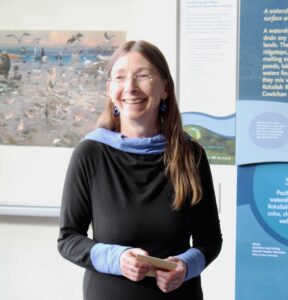When people find ways to contribute in positive ways, it solidifies how we can make a more equitable, just and environmentally-sound place for everyone.”
– Jane Kilthei, Board Member, Cowichan Estuary Nature Centre
The link between midwifery and building strong water ecosystems may not be immediately obvious. But for Jane Kilthei, the connection is clear.
“As a midwife, I got to know whole families. I care about the many children born into my hands who are now having babies of their own,” says Jane, who was a practicing midwife for 15 years before working another 17 as the Executive Director and Registrar at the College of Midwives of BC. “I want (all these children) to live in a healthy world and have a healthy future.”

Teaching children for the future
Over the past many decades, it’s fair to say that Jane has been doing more than her share to help build strong prospects for generations to come. She speaks of “children’s curiosity about nature” and “their soaking up of nature’s lessons” as key reasons why children can affect change – including the inevitable impact on their own parents’ lives. As Jane summarizes, “teaching children gives ecosystem education a wider reach.”
Jane was initially recruited from her home in Ontario, in 1997, to help position midwifery practice inside BC’s healthcare system. But living year-round in an urban environment wasn’t possible, so she negotiated splitting her time between Vancouver and Vancouver Island. Proximity to water ecosystems is her lifeline of sorts, prompted by growing up along the many rivers and lakes in Southern Alberta and Saskatchewan.
Taking care of our environment
“A lot of people move to the West Coast, but there are so many things about the ecosystems here that people don’t know about when we arrive. We want to look out on the water, but we don’t realize how responsible we are for shorelines, plant life, marine life… how much nature relies on our care.”
After moving to Cowichan Bay, Jane became engaged in community conversations with those concerned about the local estuary – “that magical place where the rivers and ocean meet” – and the need for education around this “complex and vulnerable ecosystem under the surface of the water”. In February 2011, after learning of funding opportunities, Jane approached the Cowichan Land Trust. They agreed to act as the charity who’d apply to create a nature interpretive centre. The only caveat was that she wrote the application and would lead the necessary fundraising for matching funding. The endeavour – which Jane summaries as “quite the journey” – fittingly culminated with the opening of the Cowichan Estuary Nature Centre on Earth Day 2012 (April 22nd).
Helping instill belief and agency
“The Centre has been a huge draw for tourists, for the local community and for schools,” says Jane. “And over the past nine years, we’ve also developed a program for youth that gives them hands on experience in restoring riparian areas – something they love to learn about and where they believe they can make a difference in their own communities today. At the same time, it pushes adults to act on the climate emergency through their Friday for the Future climate strikes.”
Educators at the Nature Centre also teach school classes about intertidal life and Citizen Science, through projects such as shellfish censuses, beach seines and eel grass restoration days.
“I’m most proud when I’m watching a kid, who may only be 7, take their grandparents around the Centre explaining with confidence what they’ve learned about – describing the salmon cycle or water cycle in detail. That’s where it really lands,” says Jane, who acknowledges her daughter’s bird photography passion, starting in Grade 6, helped strengthen her own love of nature. “When we can all take a deep breath, I think we can see that everything in life is interconnected.”
And while the interconnection of life today, particularly as it relates to the effects of climate change, may be anxiety-provoking for many, Jane sees this as an opportunity to further connect and collaborate.
Encouraging ways to contribute
“When people find ways to contribute in positive ways, it solidifies how we can make a more equitable, just and environmentally-sound place for everyone. And there are so many places to plug in.”
Getting involved or staying informed may have been challenging for various reasons throughout the pandemic, and Jane remains clear that staying engaged and adaptable are key to building resilience. Strong communities, she says, are ones where there is enduring relationship building, communication and connection.
Listening and problem-solving
“I think resilience is an approach to life that includes both looking ‘big picture’ – at systems and changes happening – while also being personally connected to the land and people in our communities in both vulnerable and curious ways,” says Jane. “It’s about slowing down and listening, as much as it is problem solving.”
Jane admits to being “relentlessly persistent and optimistic about working for a better world”. Turning 70, she says, has also left her thinking more about how she can mentor others to carry on her work – just one more reason she is drawn to working with younger generations.
###
Jane is actively involved in several other local ecosystem-related groups, climate change, social justice and other work with youth.
Get in touch with Jane
(250) 748-8506
jane@resiliencematters.ca
www.cowichanestuary.ca
Share your story
We’re honoured to present stories from inspiring people who are creating positive impacts in communities across the coast. If you have a story idea you think we should share, please reach out to us!